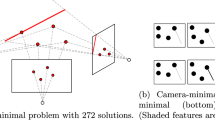Abstract
Let three projected images of a set of lines in space be given. Then, in general, the relative positions of the lines can be reconstructed uniquely up to a collineation of space. Reconstruction fails to be unique for certain critical sets of lines. It is known that each critical set is parameterised by a Bordiga surface in ℙ4. A new proof of this result is given. In addition, it is shown that every Bordiga surface parameterises a critical set of lines. The proof involves an explicit construction of the second or spurious set of lines which projects down to the same three images as the veridical set of lines.
Similar content being viewed by others
Explore related subjects
Discover the latest articles, news and stories from top researchers in related subjects.References
Bordiga, G.: La superficie del 6° ordine, con dieci rette, nello spazio R4; e le sue proiezioni nello spazio ordinario. Mem. Atti. Accad. Lincei, Series 4a (classe di scienze fisiche ecc.)4, 182–203 (1887)
Buchanan, T.: On the critical set for photogrammetric reconstruction using line tokens in ℙ3(ℂ). Geometriae Dedicata44, 223–232 (1992)
Buchanan, T.: Critical sets for 3D reconstruction using lines. In: Sandini, G. (ed.) Computer Vision — ECCV'92. Lecture Notes in Computer Science, Vol. 588. Berlin, Heidelberg, New York: Springer 1992
Faugeras, O. D., Maybank, S. J.: Motion from point matches: multiplicity of solutions. Int. J. Computer Vision4, 225–246 (1990)
Faugeras, O. D., Papadopoulo, T.: Disambiguating stereo matches with spatio-temporal surfaces. In: Mundy, J. L., Zisserman, A. (eds.) Geometric Invariance in Computer Vision. Cambridge MA, USA: MIT Press 1992
Hartshorne, R.: Algebraic Geometry. Springer Graduate Texts in Mathematics52. Berlin, Heidelberg, New York: Springer 1977
Kruppa, E.: Zur Ermittlung eines Objektes aus zwei Perspektiven mit innerer Orientierung. Sitz.-Ber. Akad. Wiss., Wien, math, naturw. Kl. Abt. IIa122, 1939–1948 (1913)
Leung, M. K., Liu, Y., Huang, T. S.: Estimating 3D vehicle motion in an outdoor scene from monocular and stereo image sequences. In: IEEE Workshop on Visual Motion, Nassau Inn, Princeton, New Jersey, 7–9 Oct. 1991, 62–68 (1991)
Liu, Y.: Rigid Object Motion Estimation from Intensity Images using Straight Line Correspondences. Ph.D. Thesis, University of Illinois at Urbana-Champaign (1990)
Liu, Y., Huang, T. S.: Estimation of rigid body motion using straight line correspondences: further results. In: Proc. 8th Int. Conference on Pattern Recognition, Paris 1986, Vol. 1, 306–309 (1986)
Liu, Y., Huang, T. S.: Estimation of rigid body motion using straight line correspondences. Computer Vision Graphics Image Processing43, 37–52 (1988)
Longuet-Higgins, H. C.: Multiple interpretations of a pair of images of a surface. Proc. R. Soc. Lond. Series A418, 1–15 (1988)
Luong, Q.-T.: Matrice Fondamentale et Autocalibration en Vision par Ordinateur. Ph.D. Thesis, L'Université de Paris-Sud, Centre d'Orsay (1992)
Maybank, S. J.: The projective geometry of ambiguous surfaces. Philosophical Trans. R. Soc. Lond, Series A332 1–47 (1990)
Maybank, S. J.: Properties of essential matrices. Int. J. Imaging Systems Technology2, 380–384 (1990)
Maybank, S. J.: Theory of Reconstruction from Image Motion. Series in Information Sciences, Vol. 28. Berlin, Heidelberg, New York: Springer 1993
Maybank, S. J., Faugeras, O. D.: A theory of self-calibration of a moving camera. Int. J. Computer Vision8, 123–152 (1992)
Navab, N.: Visual motion of lines and cooperation between motion and stereo. Dissertation, University of Paris XI, Orsay, Paris, France (1993)
Navab, N., Faugeras, O. D., Viéville, T.: The critical sets of lines for camera displacement estimation: a mixed Euclidean-projective and constructive approach. In: Proc. 4th Int. Conf.on Computer Vision, ICCV93, 713–723, Berlin, Germany (11–14 May 1993)
Room, T. G.: The Geometry of Determinantal Loci. Cambridge, UK: Cambridge University Press 1938
Semple, J. G.: On representations of line-congruences of the second and third orders. Proc. London Math. Soc. Series 2,35, 294–324 (1935)
Semple, J. G., Kneebone, G. T.: Algebraic Projective Geometry. Oxford: Oxford University Press 1953 (reprinted 1979)
Semple, J. G., Roth, L.: Introduction to Algebraic Geometry. Oxford: Clarendon Press 1949 (reprinted 1985)
Spetsakis, M. E., Aloimonos, J.: Structure from motion using line correspondences. Int. J. Computer Vision4, 171–183 (1990)
Wolf, P. R.: Elements of Photogrammetry. Second edition, Singapore: McGraw-Hill 1986
Wolfram, S. Mathematica: a system for doing mathematics by computer. Second edition, Redwood City, CA, USA: Addison Wesley 1991
Author information
Authors and Affiliations
Rights and permissions
About this article
Cite this article
Maybank, S.J. The critical line congruence for reconstruction from three images. AAECC 6, 89–113 (1995). https://doi.org/10.1007/BF01225646
Received:
Revised:
Issue Date:
DOI: https://doi.org/10.1007/BF01225646




